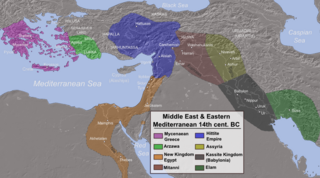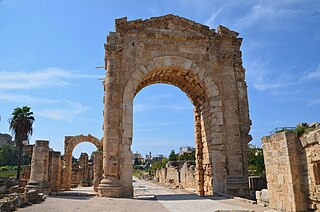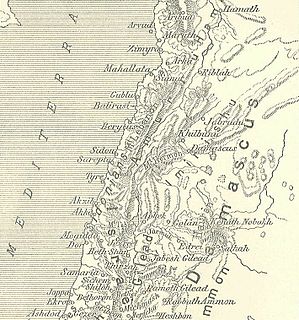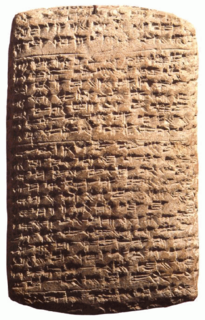
Amarna is an extensive Egyptian archaeological site containing the remains of what was the capital city of the late Eighteenth Dynasty. The city was established in 1346 BC, built at the direction of the Pharaoh Akhenaten, and abandoned shortly after his death in 1332 BC. The name that the ancient Egyptians used for the city is transliterated in English as Akhetaten or Akhetaton, meaning "the horizon of the Aten".

Akhenaten, also spelled Echnaton, Akhenaton,, was an ancient Egyptian pharaoh reigning c. 1353–1336 or 1351–1334 BC, the tenth ruler of the Eighteenth Dynasty. Before the fifth year of his reign, he was known as Amenhotep IV.

Neferneferuaten Nefertiti was a queen of the 18th Dynasty of Ancient Egypt, the great royal wife of Pharaoh Akhenaten. Nefertiti and her husband were known for a religious revolution, in which they worshipped solely the sun disc, Aten, as the only god. With her husband, she reigned at what was arguably the wealthiest period of ancient Egyptian history. Some scholars believe that Nefertiti ruled briefly as Neferneferuaten after her husband's death and before the ascension of Tutankhamun, although this identification is a matter of ongoing debate. If Nefertiti did rule as Pharaoh, her reign was marked by the fall of Amarna and relocation of the capital back to the traditional city of Thebes.

Kadesh, or Qadesh, was an ancient city of the Levant on or near the headwaters or a ford of the Orontes River. It was of some importance during the Late Bronze Age and is mentioned in the Amarna letters. It was the site of the Battle of Kadesh between the Hittite and Egyptian empires in the 13th century BC.

The Amarna letters are an archive, written on clay tablets, primarily consisting of diplomatic correspondence between the Egyptian administration and its representatives in Canaan and Amurru, or neighboring kingdom leaders, during the New Kingdom, between c. 1360–1332 BC. The letters were found in Upper Egypt at el-Amarna, the modern name for the ancient Egyptian capital of Akhetaten, founded by pharaoh Akhenaten (1350s–1330s BC) during the Eighteenth Dynasty of Egypt. The Amarna letters are unusual in Egyptological research, because they are mostly written in a script known as Akkadian cuneiform, the writing system of ancient Mesopotamia, rather than that of ancient Egypt, and the language used has sometimes been characterised as a mixed language, Canaanite-Akkadian. The written correspondence spans a period of at most thirty years.

Alashiya, also spelled Alasiya, also known as the Kingdom of Alashiya, was a state which existed in the Middle and Late Bronze Ages, and was situated somewhere in the Eastern Mediterranean. It was a major source of goods, especially copper, for ancient Egypt and other states in the Ancient Near East. It is referred to in a number of the surviving texts and is now thought to be the ancient name of Cyprus, or an area of Cyprus. This was confirmed by the scientific analysis performed in the Tel Aviv University of the clay tablets which were sent from Alashiya to other rulers.
The Amarna Period was an era of Egyptian history during the later half of the Eighteenth Dynasty when the royal residence of the pharaoh and his queen was shifted to Akhetaten in what is now Amarna. It was marked by the reign of Amenhotep IV, who changed his name to Akhenaten in order to reflect the dramatic change of Egypt's polytheistic religion into one where the sun disc Aten was worshipped over all other gods. The Egyptian pantheon was restored under Akhenaten's successor, Tutankhamun.

Kadašman-Enlil I, typically rendered mka-dáš-man-dEN.LÍL in contemporary inscriptions, was a Kassite King of Babylon from ca. 1374 BC to 1360 BC, perhaps the 18th of the dynasty. He is known to have been a contemporary of Amenhotep III of Egypt, with whom he corresponded. This places Kadašman-Enlil securely to the first half of the 14th century BC by most standard chronologies.

Abdi-Heba was a local chieftain of Jerusalem during the Amarna period. Abdi-Heba's name can be translated as "servant of Hebat", a Hurrian goddess. Whether Abdi-Heba was himself of Hurrian descent is unknown, as is the relationship between the general populace of pre-Israelite Jerusalem and the Hurrians. Egyptian documents have him deny he was a mayor (ḫazānu) and assert he is a soldier (we'w), the implication being he was the son of a local chief sent to Egypt to receive military training there.

Ushu was an ancient mainland city that supplied the city of Tyre with water, supplies and burial grounds. Its name was based upon the mythical figure Usoos or Ousoüs, a descendant of Genos and Genea whose children allegedly discovered fire, as recorded by Sanchuniathon (Sankunyaton).
Tjaru was an ancient Egyptian fortress on the Way of Horus or Horus military road, the major road leading out of Egypt into Canaan. It was known in Greek as Selē, in Latin as Sile or Sele, and in Coptic as Selē or Slē. It has been suggested that its remains form the Tel el-Habua near Qantarah.

Barga was an ancient city and later kingdom in the Syrian Coastal Mountain Range in the Bronze age and Iron age.

The Pitati were a contingent of archers of ancient Egypt that were often requested and dispatched to support Egyptian vassals in Canaan. They are recorded in the correspondence of the 1350 BC Amarna letters, and were often requested to defend against the Habiru, also rogue vassal-kings and foreign troops of neighboring kingdoms, who were on the attack.

Ruhizzi, was a city, or city-state located in northern Canaan or southern Amurru territories, in the foothills of Mount Hermon during the time of the Amarna letters correspondence. During the 15-20 year Amarna letters of 1350-1335 BC, Arsawuya was the 'mayor' of Ruhizzi and corresponded with the Egyptian pharaoh.
Rubutu was a city, or city-state located in ancient northern Israel, between the city of Gazru-(modern Gezer), and Jerusalem during the time of the Amarna letters correspondence, a 15-20 year period at about 1350-1335 BC. Some scholars place Rubutu near present-day Arrabah in the northern West Bank.
Nuribta, also Nuribda, was a city, or city-state located in the vicinity of Magiddo in Israel, in historical Canaan during the time of the Amarna letters correspondence, a 15-20 year period of about 1350-1335 BC.

Tel Hanaton is an archaeological tell situated at the western edge of the Beit Netofa Valley, in the western Lower Galilee region of Israel, 2 km south of the Town of Kfar Manda and 1 km northeast of the kibbutz which took its name, Hanaton.

Amarna letter EA 9 is a tall, compact 38 line clay tablet letter of 3 paragraphs, in pristine condition, with few flaws on the clay. The photo of the reverse (pictured) shows half of Paragraph III, and some of the signs.

Amarna Letter EA10 is the letter of the Amarna series of diplomatic correspondence designated EA 10, which is written in cuneiform writing showing the continuation of a correspondence between Burna-Buriash II an ancient king of Babylon, and Akhenaten, an ancient pharaoh of Egypt.

Amarna letter EA 156, titled: "Aziru of Amurru", is a very short letter from Aziru, the leader of the region of Amurru. EA 156 is the first letter in a series of 16 letters regarding Aziru.
















